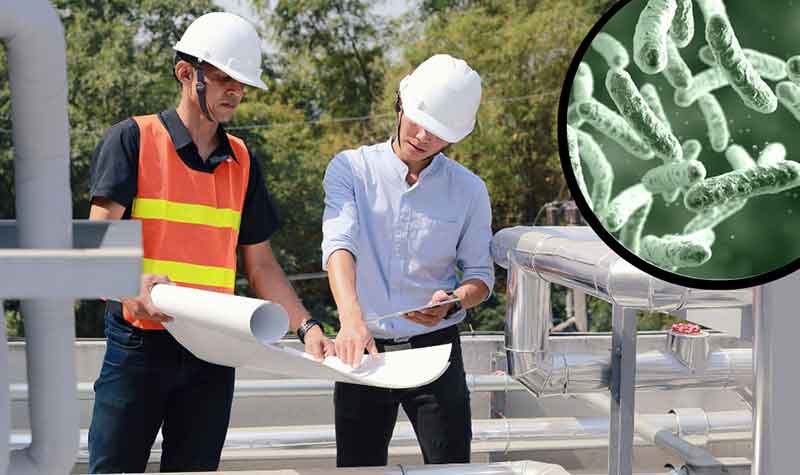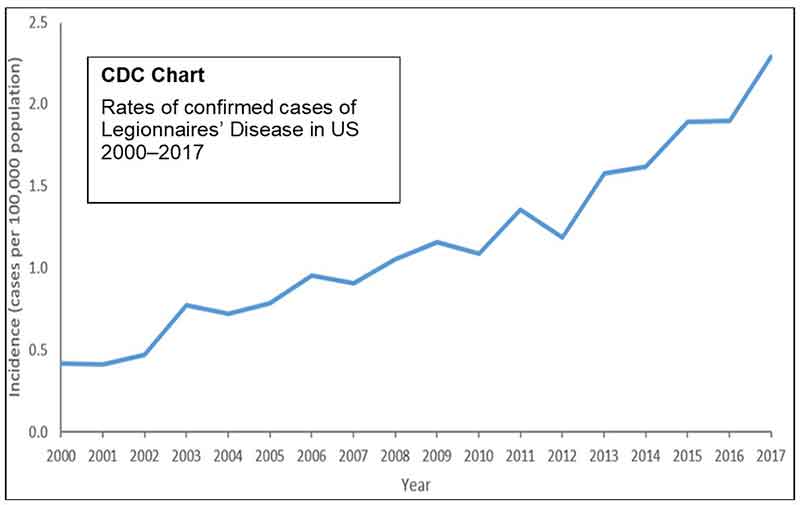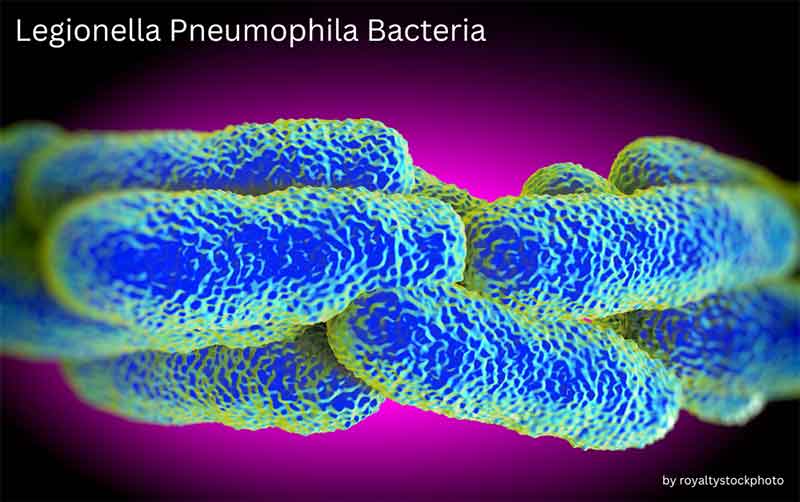
One of the primary responsibilities of a Facility Manager is to maintain a safe and healthy environment for building occupants. A rising concern among health departments and building owners / managers is a bacteria known as Legionella, which can grow within a building’s shared water systems, and can cause a very dangerous illness known as Legionnaires’ Disease.
According to the US Centers for Disease Control and Prevention (CDC), reported cases of Legionnaires’ Disease have been on the rise (see chart below). Nearly 10,000 US cases were reported in 2018, a number which does not include those unreported or misdiagnosed. Managers of built environments (whether a single building or campus) such as hospitals, schools, and commercial buildings should consider whether they need (or are required to have) a Legionella Management Plan for their facility.

FMI on this chart, and more stats and facts about Legionnaires’ disease from CDC click here.
What is Legionella
Legionella is a naturally occurring bacterial organism in the Legionellaceae family which thrives in aquatic environments.

Although it can be easily found in the natural environment worldwide, legionella becomes most dangerous to humans when it grows within the water system of a building (cooling towers, showers, faucets, hot tubs, water heaters, etc.).
Inhalation of mist / water droplets containing the bacteria can cause human illness, ranging from moderate to severe in nature.
Illnesses attributed to Legionella exposure include:
• Pontiac Fever (a mild flu-like infection)
• Legionellosis (a respiratory disease)
• Legionnaire’s Disease, aka Legionella Pneumonia (a severe form of pneumonia with a mortality rate of 1 in 10)
Legionella History
The term Legionella was coined in 1976 after an outbreak of illness at an American Legion convention in Philadelphia. In the days and weeks following the event, 182 of the convention participants became seriously ill, and 29 of them died. A lengthy investigation by the CDC and Pennsylvania Department of Health traced the cause of the outbreak to Legionella (bacteria) growth in the cooling tower at the convention site.

Who is at Risk for Legionella Related Illness?
Most otherwise healthy individuals are not likely to contract a serious illness upon exposure to Legionella, and Legionnaires’ Disease is not considered contagious.
Populations most at risk from Legionella related illness include:
• 50+ or older
• Current and former smokers
• Those with COPD, emphysema, etc.
• Immunocompromised individuals
Where is Legionella Bacteria Found?
Although the bacteria can thrive in any aquatic environment, Legionella contamination and the associated illness outbreaks are most commonly associated with the premise plumbing of buildings with large, complex water systems, such as hospitals, apartment complexes, hotels, cruise ships, etc.
Sources of legionella contamination can include:
• Showers
• Faucets
• Fountains
• Hot Tubs
• Cooling Towers
• Water Heaters
• Sprinkler Systems
• Ice Makers

Left unchecked, Legionella can thrive in indoor fountains, waterfalls, & bubblers, exposing humans to contaminated mist.
Should You Implement a Legionella Management Plan?
Studies by the CDC have shown that most Legionella outbreaks of the past could have been avoided if there had been more effective water management plans in place.
An outbreak of legionella related illness can be devastating to a community, and the responsible parties can face public backlash and lawsuits. Prevention is key.
Regularly cleaning, maintaining, and testing your building’s water systems will help thwart the growth of biofilm and dangerous bacteria such as Legionella. This form from the CDC may be helpful as you research options and prepare your facility for a legionella risk assessment.
Is Legionella Regulated?
While there are currently no EPA regulations mandating Legionella testing, as cases of Legionnaires’ Disease increase, certain cities, states, agencies, and industry groups are implementing their own guidance standards and best practices in order to control Legionella outbreaks.
Throughout the US, health codes, licensing prerequisites, and other mandates are being developed or amended with Legionella prevention in mind, and therefore building owners and facility managers should check the specific Legionella requirements in their region.
If your building falls into any of the following categories, it is best practice to consult your Health Department about creating and implementing a Legionella Management Plan:
• Healthcare facilities which house or treat immunocompromised patients
• Large buildings with occupants 60 years or older (i.e., assisted living and long-term care facilities, etc.)
• Multi-unit complexes with centralized hot water systems
• Buildings with cooling towers, hot tubs, and/or fountains
• Buildings with centralized water systems for misting, atomizing, humidifying, etc.

What’s Involved in Legionella Management?
When you initiate a Legionella Plan, a trained Legionella investigator will assess your entire building, or building complex, in order to identify potential sources of Legionella growth. All water systems in the building, including cooling towers, sinks, faucets, ice makers, showers, water heaters, fountains, and hot tubs will be identified, sampled, and tested. Any positive Legionella test results will be reported, and a remediation plan will be created.
Remediation options (and associated costs) for Legionella contamination will vary widely depending on the size of the building, water systems involved, and many other factors.
Some options for Legionella remediation include:
• Treat with a Chlorine or Bromine based solution
• Heat the water within the system to at least 158° F, for at least 24 hours
• and/or replace all plumbing hardware in question.
Once fully remediated, all identified sources should be re-tested. When Legionella tests come back negative and the building is given a clearance report, normal operations may resume. As noted earlier, routine environmental sampling is recommended to keep the building’s water systems (and occupants) healthy.

Conclusion
Discovering (and immediately resolving) a Legionella issue through your routine testing and maintenance program, while not ideal, is an infinitely better scenario than finding out through the CDC (and/or the media) that a Legionnaires’ Disease outbreak traced back to your facility. Before creating and implementing your Legionella Management Plan, be sure to check with your state and municipal agencies about the specific legionella requirements and protocols in your area.
Sources and Helpful Links:
EPA Legionella Page:
https://www.epa.gov/ground-water-and-drinking-water/legionella
CDC Info on Legionella Management:
https://www.cdc.gov/legionella/downloads/toolkit.pdf
Vital Signs Brochure for Legionnaires’ Disease:
https://www.cdc.gov/vitalsigns/pdf/2016-06-vitalsigns.pdf
CDC Info on Legionnaires Disease:
https://www.cdc.gov/legionella/about/index.html
Legionella Guidelines and Regulation in the United States:
https://www.ncbi.nlm.nih.gov/books/NBK555112/
Legionella Testing & Management Services from ARA:
https://www.absoluteresourceassociates.com/services/air-quality/legionella/


